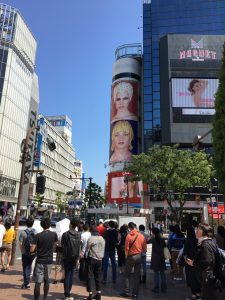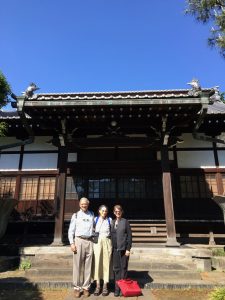We have arrived into the intensely busy crowded metropolis of Tokyo — but our ride from the airport into town is eerily quick and trafficless as this is Golden Week, when almost everyone in this country is out of town visiting relatives or vacationing. I don’t mean the city is empty, by any means – Shinjuku Station, near our hotel, is a swarm of young people. And Shibuya, the times square of Japan (shown below), is also alive – but with crowds far more polite and orderly than its NY equivalent. The great contrasts within Japan from the very new to the very old, from one moment to another, are one of the aspects of travel in this country which makes it so fascinating to us who consider 100 year old buildings as ancient artifacts.
Our guide for our two days in Tokyo is young and helpful and takes us to some of his favorite areas of his city, none of which I had seen in a number of earlier trips to this part of the world:
Fukagawa Fudo Temple, in a part of Tokyo which once was the original city of Edo, is a large imposing structure imported from another part of Japan after the original was destroyed in WWII, as was much of Tokyo. There we watched the daily Goma fire ritual performed with great pomp and circumstances by the local priests, gold and red gowned, with black and grey young trainees striking the great taiko drums, as well as bells and wooden clappers. With burning incense and fire to aid the fulfillment of wishes promised by this form of Esoteric Shingon Buddhism, it was impressive and memorable to us all.
The nearby Tomioka Hachimangu Shrine, a Shinto shrine and the birthplace of Sumo wrestling, with its red pillars and hangings, was also replaced post WWII after the older version burned in the great fires of Tokyo.
One of the benefits of a local guide is finding restaurants one could not otherwise locate, usually up a flight of stairs with little signage down below. For lunch today we went to an udon noodle restaurant hidden in an atmospheric neighborhood and we all had a fabulous meal at a tatami mat room with a low table.
Our next stop was the Nezu area of town, which survived the war devastation and retains a sense of history. We wandered around the charming narrow streets with interesting small houses and shops. We all noticed the amazing attention the householders paid to potted plants around the homes, creating beautiful small gardens in very small spaces. Nestled among the concrete block newer homes and apartments was the occasional old wood structure, standing regally among its younger neighbors, quiet and serene.
The Nezu Shrine, established in 1705, was a sudden hive of activity as it was the middle of its annual spring Azalea festival — which had past its prime but still had a long line of visitors waiting to enter. We walked through the long string of vermillion tori gates, modeled after those of the great Shinto shrine in Kyoto and around through the commercial stalls selling everything from antique mish-mash to new fashionable denim hats and a memorable hawker of fresh oranges, proclaiming his wares with samples and grand gestures.
Our last stop was the Rikugi Japanese Garden in the Bunkyo district, an ancient strolling garden from the Edo era — a beautiful garden surrounding by a lake, a man-made hill and a great serenity.
We traveled everywhere on the Tokyo Subway system as well as buses, noting how quiet and polite people are everywhere, while we loud Americans, calling to each other, stuck out from a very different culture. It was still the Golden Week Holiday and the trains were nevertheless very crowded and made me wonder what the commute was like during rush hours during a work week.
The highlight of our voyaging the next day was the Jiyu-Gakuen Myonichi-kan, a school designed by Frank Lloyd Wright in 1923 and completed with an addition by Arata Endo in 1927. Totally renovated within the last 20 years, it retains the wonderful wooden details and Oya stone characteristic of Wrights work in Japan at the time and was a delight for Bill, of course, and of great interest to the rest of us as well.
Lunch at another great small upstairs restaurant, this time specializing in soba buckwheat noodles was a quiet respite before setting off for our last 2 stops: the Hokusai museum, with a wonderful exhibit of his water-inspired images, leading up to his monomental Great Wave in a very modern building (below). And finally the Amuse Museum, with a fabulous exhibition of old textiles which was located right next to the great Asakusa Temple, intensely crowded as a sight for every tourist who comes to Japan.
The ATMs work well for us at the ubiquitous 7-11 shops all over the county so cash has been no problem. Our hotel was luxurious with a fabulous breakfast buffet and comfortable beds — although sleep came hard for some of us (especially me) given the 8 hour time difference from the western U.S.
The culmination of my Tokyo experience was the temple-style vegetarian restaurant which Trisha, Bill and I indulged in on Saturday night – 12 spring-themed courses, served to us in our private tatami room with traditional service, kimono-clad servers bowing to us and explaining each dish. It was Boys Day so one course was an artful depiction of boys games. See the lacrosse stick, golf club and basketball below.
A long expensive taxi ride brought us back to the hotel, delighted with our experience and sated with food.
Despite weather predictions of rain, we have had spectacular weather, sunny and low 70’s, and all of us seem happy and well.













